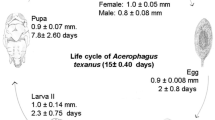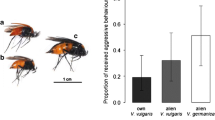Summary
Aethalion reticulatum nymphs and adults were found feeding onPiper umbellatum in Costa Rica. Adult females protected their egg masses by sitting atop the masses and scraping their hind legs along the sides. Two parasitoids,Gonatocerus sp. andPterygogramma sp. were reared from egg masses. Nymphs and adults were regularly tended byCamponotus sericeiventris andCamponotus (Tanaemyrmex) sp.Camponotus sericeiventris tended only during the daylight hours and aggressively protected the hemipterans.Camponotus (Tanaemyrmex) sp. was competitively displaced by the former species.
Resumen
Las ninfas y adultos deAethalion reticulatum fueron encontrados alimentandose dePiper umbellatum en Costa Rica. Las hembras protegian sus huevos sentados encima de ellos y frotundo los miembros posteriores con los lados de las masas de huevos. Dos parasitos fueron criados en los huevos,Gonatocerus sp. yPterygogramma sp. Ninfas y adultos eran protegidos regularmente por losCamponotus sericeiventrisyCamponotus (Tanaemyrmex) sp. LosC. sericeiventris cuidaban a las hemipteras durante las horas del día solamente y las protegian agresivamente. LosCamponotus (Tanaemyrmex) sp. fueron desalojados en competencia por las especies primarias.
Résumé
Nous avons trouvé des nymphes et des imagos deAethalion reticulatum qui se nourrissaient surPiper umbellatum à Costa Rica. Les femelles protégeaient leur amas d'œufs en se tenant à leur sommet et en frottant leurs pattes arrières sur les côtés de l'amas. Deux parasitoïdes,Gonatocerus sp. etPterygogramma sp., furent élevés au sein des amas d'œufs.Camponotus sericeiventris etCamponotus (Tanaemyrmex) sp. prenaient réguliérement soin des nymphes et des imagos. C'est seulement le jour queCamponotus sericeiventris s'occupait des Hémiptères et les protégeait de façon agressive.Camponotus (Tanaemyrmex) sp. était supplantée par l'espèce précédente, plus compétitive.
Similar content being viewed by others
References
Azevedo Marques (L. A. de), 1925. — A cigarrinha nociva aos pomares (Aethalion reticulatum L.).Chacaras Quint., 32, 33–37.
Azevedo Marques (L. A. de), 1928. — Cigarrinha nociva a varias especies de vegetaes.Bolm. Inst. biol. Def. agric., Rio de J., 6, 1–27.
Brian (M. V.), 1955. — Food collection by a Scottish ant community.J. Anim. Ecol., 24, 336–351.
Brown (W. L.), — ConcerningTanaemyrmex. Personal communication.
El-Ziady (S.) andKennedy (J. S.), 1956. — Beneficial effects of the common garden ant,Lasius niger L., on the black bean aphid,Aphis fabae Scopoli.Proc. R. ent. Soc. Lond., Ser. A,31, 61–65.
Herzig (J.), 1937. — Ameisen und Blattläuse.Z. angew. Ent., 24, 367–435.
Myers (J. G.), 1931. — Descriptions and records of parasitic Hymenoptera from British Guiana and the West Indies.Bull. ent. Res., 22, 267–277.
Smith (H. S.) andArmitage (H. M.), 1931. — The biological control of mealybugs attacking eitrus.Bull. Calif. agric. Exp. Stn., 509, 1–74.
Strickland (A. H.), 1951. — The entomology of swollen shoot of cacao. II. The bionomics and ecology of the species involved.Bull. ent. Res., 42, 65–103.
Way (M. J.),— Studies on the association of the antOecophylla longinoda (Latr.) (Formicidae) with the scale insectSaissetia zanzibarensis Williams (Coccidae).Bull. ent. Res.,45, 113–134.
Way (M. J.), 1963. — Mutualism between ants and honeydew-producing Homoptera.A. Rev. Ent., 8, 307–344.
Wheeler (W. M.),1910. — Ants: Their Structure, Development and Behavior.Columbia University Press, édit., New York, 663 p.
Wilson (E. O.), 1971. — The Insect Societies.Harvard University Press,édit. Cambridge, Ma., 548.
Author information
Authors and Affiliations
Rights and permissions
About this article
Cite this article
Brown, R.L. Behavioral observations onAethalion reticulatum (Hem., Aethalionidae) and associated ants. Ins. Soc 23, 99–107 (1976). https://doi.org/10.1007/BF02223844
Received:
Accepted:
Issue Date:
DOI: https://doi.org/10.1007/BF02223844




